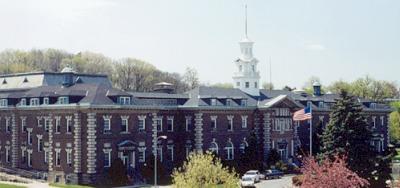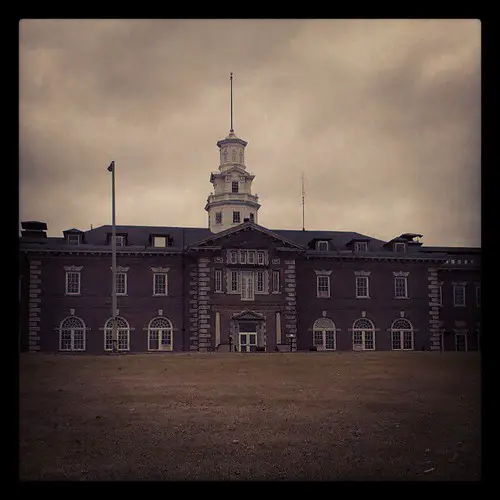An iconic institution once stood in the heart of Allentown, Pennsylvania – the Allentown State Hospital. With its imposing façade and sprawling campus, this grand edifice significantly shaped the local community. Its history is a tapestry of human resilience, medical innovation, and societal change. It was a beacon of hope for those seeking solace and healing for over a century.
However, the hospital is not just a relic of the past; its legacy continues to echo in the present. The hospital’s influence permeates the local culture, and its physical absence is a poignant reminder of its significant role in Allentown’s history.
This article aims to bring this fascinating story to life, taking readers on a journey through time, from the hospital’s birth to its ultimate closure.
The Birth of Allentown State Hospital
The Germantown Homeopathic Medical Society of Philadelphia sparked the genesis of the Allentown State Hospital. They envisioned a place where the mentally ill could receive compassionate, homeopathic care.
After several attempts and unwavering determination, the society’s vision became a reality when a bill was passed in June 1901, paving the way for establishing the hospital.
The selection of the site for the hospital was a meticulous process. Various locations across several counties were considered before deciding on a tract of land in Hanover Township, near Allentown. This 209-acre plot, with its serene surroundings, was deemed the perfect location for the hospital. The cornerstone was laid on June 27, 1904, marking the beginning of an era.
However, the hospital’s journey was not without hurdles. Insufficient state revenue led to a delay in the construction of the buildings. Despite the financial constraints, the hospital stood as a testament to the unwavering resolve of its founders and the local community, who eagerly awaited its completion.
The Construction Saga
The Allentown State Hospital was built on the northern banks of the Lehigh River, conveniently located between Allentown and Bethlehem.
The hospital’s construction was an architectural feat, with its administration department, ward buildings, chapels, dining rooms, operating room, auditorium, laundry building, and power and electric light plant.
Despite the financial challenges and the ensuing delays, the hospital, once completed, was a sight to behold. The Kirkbride block plan, an architectural style standard in large institutions in the late 19th and early 20th centuries, was used as the blueprint for the hospital. The interconnected corridors and dormitories created a sense of community among the patients.
The hospital’s prime location and comprehensive facilities were a testament to the foresight of its founders. The total cost of the land and the construction of the buildings amounted to a substantial $1,931,000. However, the value of the hospital’s services to the community far exceeded this monetary figure.

Operational Years and Challenges
The hospital opened its doors to patients on October 3, 1912, under the leadership of Superintendent Henry I. Klopp. Initially, the hospital had a capacity of 1000 patients, and by the end of May 1913, the hospital had admitted 934 patients.
The hospital’s operation emphasized the treatment of “recoverable” patients and employed various therapeutic methods, including diversional occupation and recreation.
Despite its contributions to mental health care, the hospital faced several challenges. The internal layout of the hospital, designed nearly a decade before its opening, was not ideal for implementing twentieth-century ideas of inpatient treatment and classification. The hospital also lacked facilities for specific treatments like continuous baths and hydro-therapeutic equipment.
The medical staff organized their work along general hospital lines, ensuring each patient received a thorough mental and physical examination. The hospital had state-of-the-art diagnostic appliances, including pathological, bacteriological, chemical, and hematological laboratory outfits, electrical and X-ray apparatus, and a dental outfit.

Medical Innovations
Allentown State Hospital was organized along general hospital lines, with each patient receiving a thorough mental and physical examination. In addition, the hospital staff employed various therapeutic methods, including rest, fresh air, nutritious food, hydrotherapy, individual attention, influence, and indicated remedies.
They also utilized occupation therapy and other forms of diversional occupation and recreation as therapeutic agents. In addition, the staff was equipped with diagnostic appliances covering various specialties, allowing them to make intelligent diagnoses and treat patients scientifically from both a medical and surgical standpoint.
The Closing and Demolition of the Hospital
The Allentown State Hospital, after nearly a century of service to the community, closed its doors on December 15, 2010. This decision was not reached lightly but resulted from several factors, including financial concerns and a shift in mental health care practices.
The need for long-term institutional care has significantly decreased with the advent of new treatment methods and medications. Many patients could now be treated in their homes and communities, leading to a decline in the hospital’s patient population. Furthermore, the large, aging building had become an eyesore and a safety hazard, requiring considerable maintenance.
In late 2019, the Pennsylvania Department of General Services announced that the former Allentown State Hospital site would be demolished. This was a difficult but necessary decision as the buildings had deteriorated over the years, posing safety concerns.

A bid process was initiated, and a contractor was chosen for demolition. The demolition process began in 2020 and was handled carefully to minimize any potential disruption to the community.
The closure and demolition of the Allentown State Hospital had a profound impact on the local community. Not only did it mark the end of an era, but it also led to the loss of jobs and a shift in local healthcare services. However, it also opened up possibilities for new developments and opportunities for the community to use the site in a way that could benefit future generations.
Conclusion
The Allentown State Hospital was a cornerstone of the community for many years. From its establishment in the early 1900s to its closure in 2010, the hospital provided care for countless patients and significantly contributed to the mental health field. Its legacy lives on in the memories of those who worked and were treated there and in the broader story of mental healthcare in Pennsylvania.

Today, the site of the former Allentown State Hospital is a testament to the changes in mental healthcare over the past century. Although the buildings are gone, the history and impact of the hospital remain etched in the community.
As the site embarks on a new chapter, the spirit of the Allentown State Hospital continues to influence the area’s future development, ensuring that it will remain a significant part of its history and community.
Bundle your hotel + flight together to save more on your next trip! Book now at Expedia.com


Really enjoyed your visit to the Allentown State Hospital. Believe it or not, my mom’s senior class trip was to this hospital. I always thought that was odd because our class trips were to places such as Gettysburg or Washington D.C. But I guess that’s the sort of trips they took back in 1957. Thanks again!
It’s great to hear that you enjoyed a visit to the Allentown State Hospital. Your mention of your mom’s senior class trip to the hospital in 1957 highlights the rich history of educational excursions. The Allentown Hospital likely held significant historical and educational value during that time. Observing how educational practices and destinations have changed over the years is intriguing.